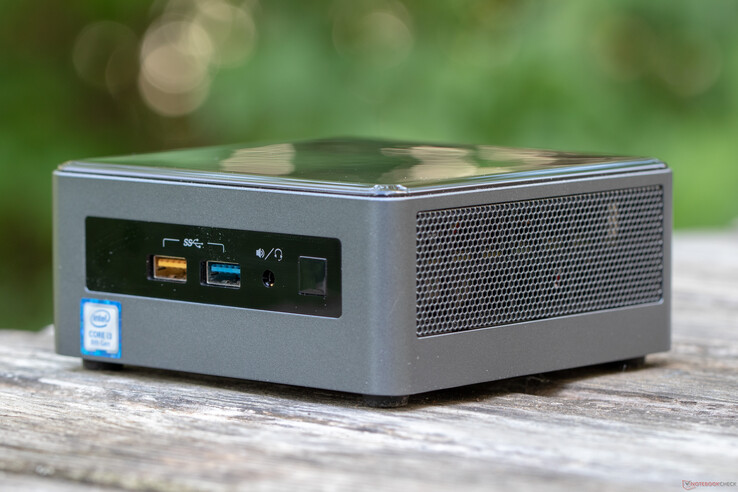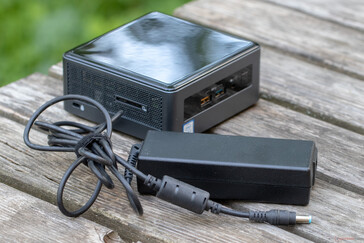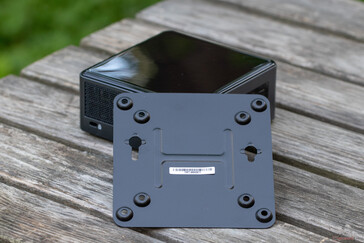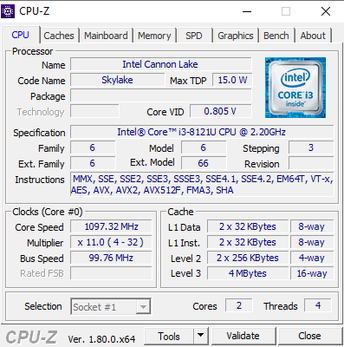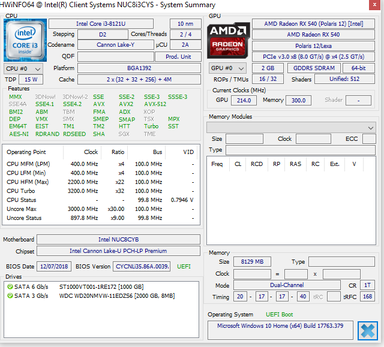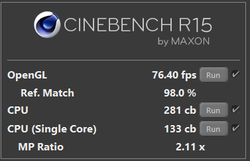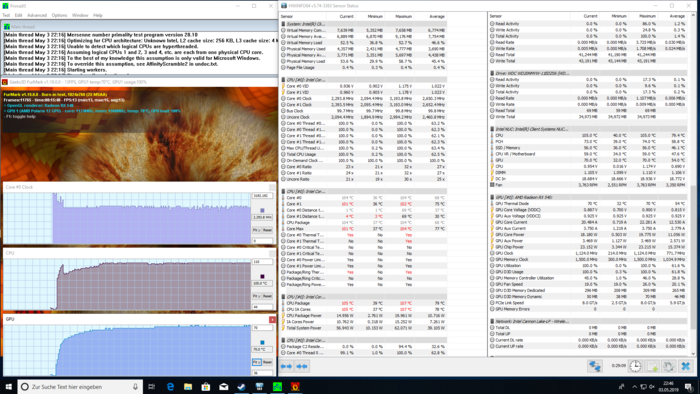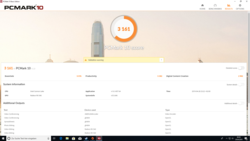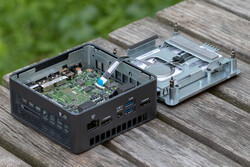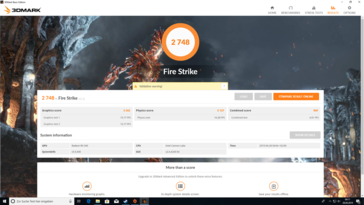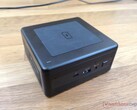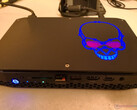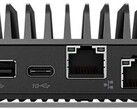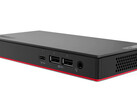Intel NUC8i3CYSM Review

The NUC product line from Intel has been expanded with one more model. The last mini PC from Intel that we reviewed was known as the NUC8i7BEH (Bean Canyon with the Core i7-8559U), and we now have the NUC8i3CYSM with the Cannon Lake-based Core i3-8121U in our lab. Both devices look very similar and are almost indistinguishable from each other. However, our current review device is a little bit bigger. The CPU manufacturing process has shrunk a little, though, from 14 nm to 10 nm. We will explain what kind of effect this has in the “Performance” section.
Intel has released a lot of NUCs over the years, some of which we shall include in this review for comparison purposes. The Zotac ZBox-CI660 Nano and the Chuwi GBOX CWI560 will also be included in our review.
- Intel NUC7CJYH
- Intel Hades Canyon NUC
- Intel Skull Canyon NUC
- Intel NUC6i5SYH
- Zotac ZBox-CI660 Nano
- Chuwi GBox CWI560
Unlike the Bean Canyon model, which comes as a barebones kit, the NUC8i3CYSM comes as a complete package. However, there are a few surprises when it comes to the choice of hardware. We are going to talk about it later.
No, or more than one (0) Rating for the given SpecsID 309262 found
Case & Hardware - Small and square
We will not talk about the case in great detail, because there are no changes to talk about when compared to the NUC8i7BEH and its predecessors. The case is still made of plastic with metal fan grills on either side of the device. The ports are located on the back and the front of the device and the glossy top cover can be removed with the hand. The whole thing looks compact and very solid; not a lot can go wrong here.
Connectivity
The ports are located on three sides of the device. On the front of the device, users will find the power button, the combination headphone/microphone jack, the IR receiver and two USB 3.0 Type-A ports. Here, the yellow port can permanently output 1.5 A, whereas other ports can only provide devices connected to them with 900 mAh. The back houses the power socket, two HDMI 2.0b ports, an Ethernet port and two additional USB 3.0 Type-A ports. The SD card reader is located on the left side of the device.
For wireless communication, the mini PC uses the Intel Wireless-AC 9560D2W adapter (802.11ac R2, 2x2).
The box contains a 90-watt power supply and a VESA mounting bracket (75 x 75 mm + 100 x 100 mm).
Performance - 10 nm with limitations, Radeon RX 540 helps out
The NUC8i3CYSM has an Intel Core i3-8121U processor with 8 GB of soldered-in RAM (2400 MHz LPDDR4). This is why the amount of RAM cannot be increased beyond 8 GB. Things are different with the HDD, which we recommend users replace with an SSD as soon as they buy the device. We recommend this because the NUC8i3CYSM comes with a 1 TB, 2.5-inch HDD that significantly limits system performance. Good news: According to the specifications sheet, the NUC can use two storage devices at the same time; in other words, its motherboard has a 2.5-inch drive bay and an M.2 slot.
The Radeon RX 540 with 2 GB of GDDR5 VRAM serves as the graphics solution. We will benchmark this GPU to see how well it can handle modern video games.
Processor
In the NUC, we meet, for the first time, the Cannon Lake-based Core i3-8121U. This CPU is produced using the 10-nm manufacturing process. However, this is not a very fast processor in terms of performance, because it has only two cores and a 15-watt TDP. The new 10-nm CPU has a base clock of 2.2 GHz and a boost clock of 3.2 GHz, which means that its boost clock is 200 MHz lower than that of the 14-nm Core i3-8130U.
The CPU scores 133 points in the single-core section of CineBench R15 and 319 points in the multi-core section. These results are not surprising and they could have been better if it were not for the low clock rates. As expected, the Intel Core i3-8121U in our NUC trounces Intel Celeron CPUs but fails to keep up with other NUCs that have Intel Core i7 processors.
Stress Test
In our stress test, we put the NUC under extreme loads by running FurMark and Prime95 at the same time. The Core i3-8121U begins the test at its full boost clock of 3.2 GHz, which eventually drops down to 2.2 GHz (base clock). The CPU frequency stabilizes after that. During the stress test, the Core i3-8121U reached a maximum temperature of 110 °C and the AMD Radeon RX 540 reached 70 °C.
System Performance
Storage Devices
The NUC8i3CYSM comes with a 1 TB HDD from Seagate (ST1000VT001-1RE172). In our opinion, this is the weakest link in the chain and we strongly recommend replacing the hard drive with an SSD. If you take a look at the benchmarks that we have conducted using CrystalDiskMark, you will see that the HDD is a huge bottleneck. Now granted, comparing HDD and SSD performance is not fair, but it reveals the potential that can be tapped into by replacing the HDD.
| Intel NUC8i3CYSM Seagate ST1000VT001 | Intel Skull Canyon NUC6i7KYK Samsung SSD 850 EVO m.2 120GB | Intel NUC7CJYH SanDisk Ultra II | Average of class Desktop | |
|---|---|---|---|---|
| CrystalDiskMark 3.0 | ||||
| Read Seq (MB/s) | 47.09 | 487.6 935% | 426.4 806% | 4740 ? 9966% |
| Write Seq (MB/s) | 81.4 | 442.7 444% | 443 444% | 6000 ? 7271% |
| Read 512 (MB/s) | 19.69 | 420.1 2034% | 309.8 1473% | 2845 ? 14349% |
| Write 512 (MB/s) | 77.9 | 379.8 388% | 365.5 369% | 4635 ? 5850% |
| Read 4k (MB/s) | 0.328 | 38.67 11690% | 29.45 8879% | 76.5 ? 23223% |
| Write 4k (MB/s) | 1.434 | 87.8 6023% | 51.7 3505% | 254 ? 17613% |
| Read 4k QD32 (MB/s) | 0.857 | 375.9 43762% | 132.8 15396% | 928 ? 108185% |
| Write 4k QD32 (MB/s) | 1.34 | 309.5 22997% | 109 8034% | 726 ? 54079% |
Graphics Card
To our surprise, the iGPU of the prematurely released Intel Core i3-8121U is disabled. Instead, what we find is a soldered-in AMD Radeon RX 540 with 2 GB of GDDR5 VRAM that is connected to the CPU via the PCIe 3.0 x4 interface. In the 3DMark benchmarks, the Radeon RX 540 in the NUC8i3CYSM handily beats Intel UHD and Iris Pro graphics but is 5% slower than the average Radeon RX 540.
| 3DMark 06 Standard Score | 18661 points | |
| 3DMark 11 Performance | 4465 points | |
| 3DMark Cloud Gate Standard Score | 9431 points | |
| 3DMark Fire Strike Score | 2748 points | |
Help | ||
Gaming Performance
Luckily, the disabled integrated graphics unit is basically irrelevant when it comes to gaming performance. Here, the Radeon RX 540 is used 100% of the time, and it is for the best.
Even though the NUC does not get impressive scores in the PCMark benchmarks, the gaming performance can be described as satisfactory. Most of the latest titles such as Anno 1800
and Far Cry New Dawn
seem quite playable on low settings. Surprisingly, Tom Clancy's The Division 2
is playable even on high settings.
| The Witcher 3 | |
| 1024x768 The Witcher 3 low | |
| Average of class Desktop (39.3 - 841, n=27, last 2 years) | |
| Average AMD Radeon RX 540 (48 - 50.8, n=2) | |
| 1366x768 The Witcher 3 medium | |
| Average of class Desktop (23.6 - 790, n=29, last 2 years) | |
| Average AMD Radeon RX 540 (29.3 - 39, n=3) | |
| 1920x1080 The Witcher 3 high | |
| Average of class Desktop (12.8 - 638, n=31, last 2 years) | |
| Average AMD Radeon RX 540 (8 - 13.2, n=2) | |
| 1920x1080 The Witcher 3 ultra | |
| Average of class Desktop (7.8 - 369, n=45, last 2 years) | |
| Average AMD Radeon RX 540 (6 - 7.8, n=2) | |
| low | med. | high | ultra | |
|---|---|---|---|---|
| Far Cry New Dawn (2019) | 40 | 18 | 17 | 16 |
| Anthem (2019) | 24 | 20 | 17 | |
| The Division 2 (2019) | 56 | 39 | 37 | 8 |
| Anno 1800 (2019) | 54 | 18 | 11 |
Pros
Cons
Verdict
It would appear as though Intel has put a CPU that is not entirely ready for prime time in the NUC8i3CYSM. You cannot see the advantages of the new 10-nm manufacturing process either on paper or in real life.
The Intel Core i3-8121U has a lower clock rate and performs worse than the Kaby Lake-based, 14-nm Intel Core i3-8130U. Moreover, both CPUs have the same TDP of 15 watts. Currently, the iGPU of the Core i3-8121U is disabled and Intel relies on AMD’s Radeon graphics solution for image-rendering instead.
Of course, we also have a few positive things to say about the new CPU, such as the fact that it supports 2400 MHz LPDDR4 RAM, whereas previous models did not support anything better than 2133 MHz LPDDR3 RAM. The Cannon Lake-based processor offers 16 PCIe 3.0 lanes instead of 12. However, Intel does not use this advantage, because it chose to put a hard drive in the NUC8i3CYSM. Those who want the system to be responsive should seriously consider getting a 2.5-inch SSD or an M.2 SSD. Because the RAM is soldered-in, you cannot bump it up to 16 GB, and there are no other upgrade options.
One cannot help but get a feeling that Intel has put a prematurely released Cannon Lake-based CPU in the NUC. Fortunately, it is helped out in a major way by AMD’s Radeon RX 540. All of this means that you should not rush out to buy this particular model just because it is produced using the 10-nm manufacturing process.




